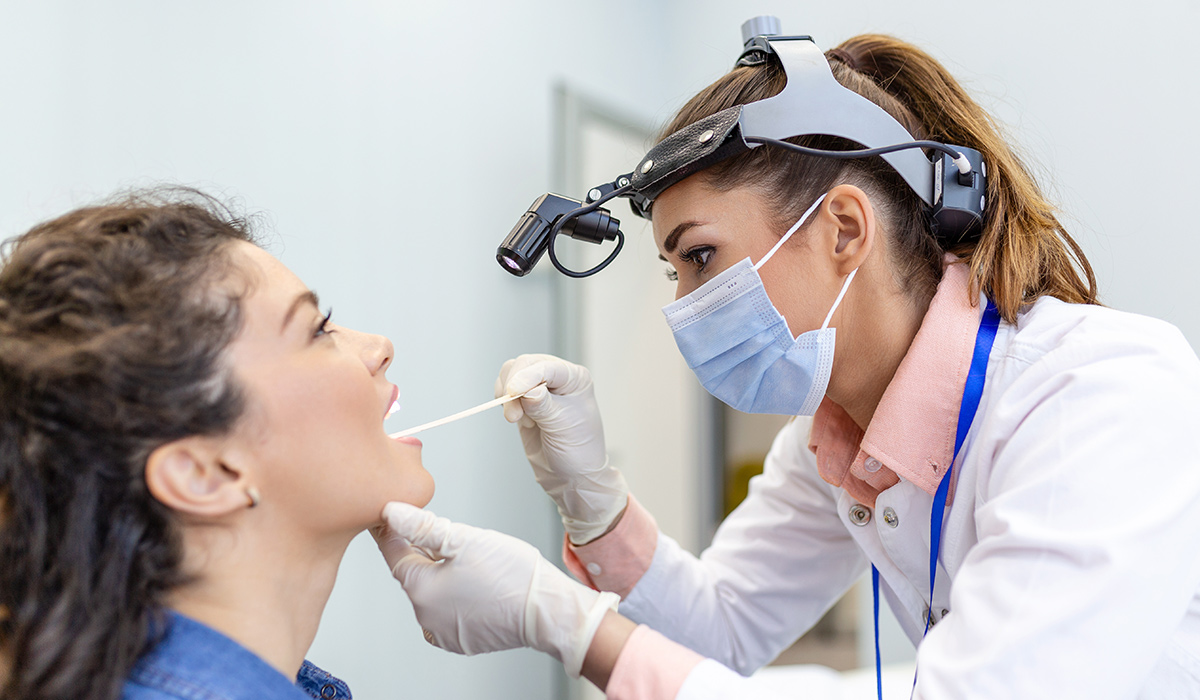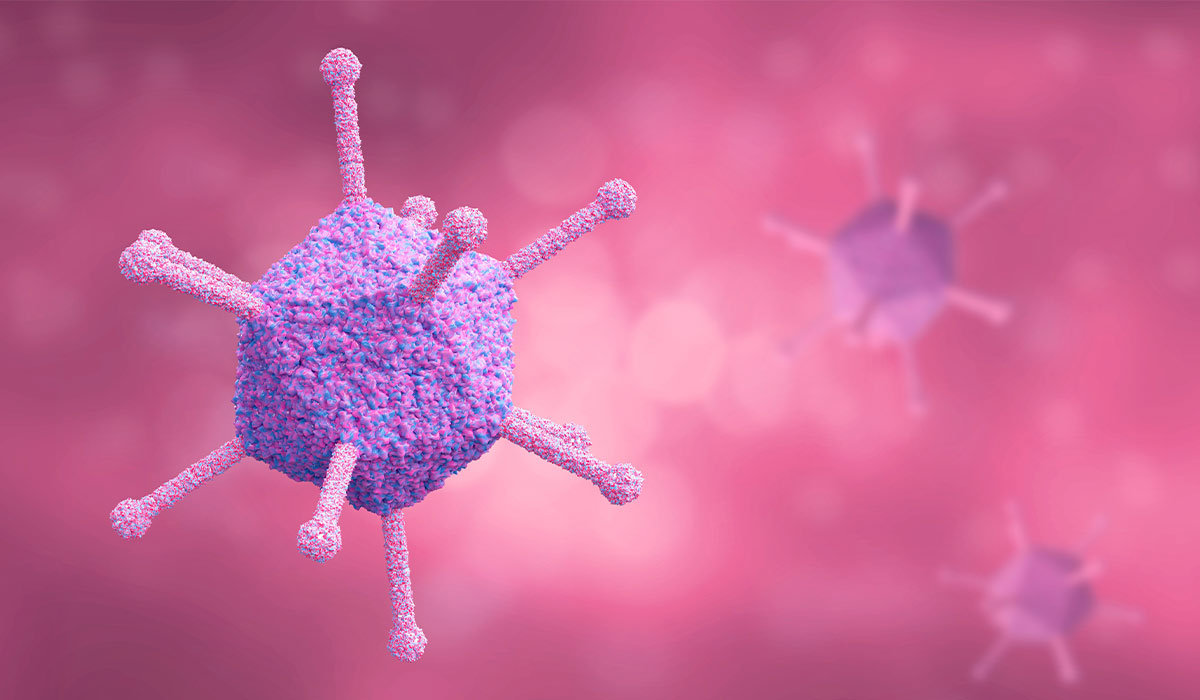Diphtheria is a type of infection with bacterial toxins. The disease is caused by Corynebacterium species, mainly Corynebacterium diphtheria, which leads to tissue necrosis and causes characteristic symptoms. Diphtheria infection of the skin and mucous membranes depends on the anatomical site of the illness and the patient's condition. However, symptoms most commonly involve a change in the appearance of the pharyngeal mucous membranes.
The disease is most common in children and people with weakened immune systems. Infection with diphtheria from another person is possible by the droplet route. The basis of diphtheria diagnosis is laboratory testing to confirm the presence of a particular strain of bacteria. Treatment of diphtheria is carried out in hospitals, as it is a life-threatening disease. Nowadays, prevention in the form of diphtheria vaccines is essential.

Diphtheria is a bacterial infection. Specifically, the condition is caused by toxins secreted by Corynebacterium species bacteria, mainly Corynebacterium diphtheria![]() . C. diphtheria is a gram-positive bacillus that is tentacle-shaped. The pathogens produce toxins that bind to receptors in human cells. This, in turn, leads to localized inflammation, the location of which can vary. Depending on where the bacteria are located, tissues in the throat, larynx, skin, and sometimes even internal organs can be damaged.
. C. diphtheria is a gram-positive bacillus that is tentacle-shaped. The pathogens produce toxins that bind to receptors in human cells. This, in turn, leads to localized inflammation, the location of which can vary. Depending on where the bacteria are located, tissues in the throat, larynx, skin, and sometimes even internal organs can be damaged.
What is particularly important in the case of diphtheria is the high contagiousness![]() of the disease. Before 1920, the incidence was high in the United States; however, the incidence of the disease dropped significantly after the introduction of vaccines. Infection usually occurs by the droplet route or due to direct contact with the patient or objects previously used by the patient.
of the disease. Before 1920, the incidence was high in the United States; however, the incidence of the disease dropped significantly after the introduction of vaccines. Infection usually occurs by the droplet route or due to direct contact with the patient or objects previously used by the patient.
Once the diphtheria bacteria enter the nose or mouth, colonization of the mucous membranes of the upper respiratory tract or skin occurs. Therefore, transmitting the bacteria is possible when staying near an infected person, especially if they are coughing, sneezing, or simply talking. If someone close to you has symptoms of diphtheria, provide appropriate personal protective equipment and a protective mask.

Several types of the disease are distinguished according to the area affected by the diphtheria bacteria. The types of disease may differ in their symptoms, but they also have general symptoms in common. Clinical types of diphtheria include:
Diphtheria most commonly involves the posterior structures of the mouth and the proximal part of the throat. C. diphtheriae multiplies on the surface of the mucosa, causing the formation of a pseudomembrane. Diphtheria can also occur as an acute upper respiratory tract disease. The diphtheria bacteria usually involve one or more of the following areas: tonsils, larynx, soft palate, uvula, or nasal cavity.
Diphtheria can also affect the skin, although these are less common. Skin lesions![]() are highly variable, and C. diphtheriae bacteria cause various symptoms. Skin lesions can have multiple origins, such as surgical wounds. They can also be ulcerative or vesicular. Often, diphtheria skin lesions occur on the feet, hands, and lower legs. Because of the various symptoms, skin lesions caused by C. diphtheriae are challenging to distinguish from other skin diseases.
are highly variable, and C. diphtheriae bacteria cause various symptoms. Skin lesions can have multiple origins, such as surgical wounds. They can also be ulcerative or vesicular. Often, diphtheria skin lesions occur on the feet, hands, and lower legs. Because of the various symptoms, skin lesions caused by C. diphtheriae are challenging to distinguish from other skin diseases.
This form of the disease is characterized by localized bacterial growth in the throat with the formation of pseudomembranes or, less commonly, in the stomach or lungs. The systemic spread of the toxin causes changes in distant organs. This severe form of the disease is hazardous and can lead to death.

Once the bacteria enter the body, the incubation period lasts two to five days. At the onset of the illness, diphtheria can produce uncharacteristic symptoms mistaken for flu or a cold. Then, symptoms appear, which makes it easier to recognize the disease. In some types of diphtheria, symptoms also extend to the skin surface. It should also be borne in mind that diphtheria is one of the patient's life-threatening diseases. Death of the patient usually occurs as a result of asphyxiation due to closure of the airways or cardiac arrest. Symptoms of diphtheria can, therefore, include:
At the onset of diphtheria, irrespective of the type of illness, non-specific flu-like symptoms appear. A fever and sore throat are usually present. A less characteristic symptom is enlarged cervical lymph nodes![]() . Lymph nodes are part of the lymphatic system and contribute to the immune system. They are made up of lumps filled with different subtypes of lymphocytes. In cases of diphtheria, the lymph nodes become enlarged, which can be recognized by the appearance of hard lumps in the neck. In addition, chills, fatigue, headaches, hoarseness, and coughing may occur during diphtheria, reminiscent of a respiratory illness.
. Lymph nodes are part of the lymphatic system and contribute to the immune system. They are made up of lumps filled with different subtypes of lymphocytes. In cases of diphtheria, the lymph nodes become enlarged, which can be recognized by the appearance of hard lumps in the neck. In addition, chills, fatigue, headaches, hoarseness, and coughing may occur during diphtheria, reminiscent of a respiratory illness.
Further symptoms follow flu-like symptoms in diphtheria. According to the subsequent symptoms, doctors are better able to diagnose the disease because of the characteristic signs. In diphtheria, first of all, there is a pseudomembrane forming a thick, grey membrane adhering to the throat, tonsils, or other areas. The pseudomembrane initially forms a mild erythema![]() , which turns into a specific white-grey coating. Pseudomembrane is a particular symptom consisting of red and white blood cells and also the remains of dead cells and organisms. With the development of the disease, the pseudomembrane may start to bleed after scraping it off the surface of the mucosa.
, which turns into a specific white-grey coating. Pseudomembrane is a particular symptom consisting of red and white blood cells and also the remains of dead cells and organisms. With the development of the disease, the pseudomembrane may start to bleed after scraping it off the surface of the mucosa.

If the cutaneous diphtheria type is present, skin lesions may appear. These are often ulcerative lesions that are covered with a specific grey membrane. Diphtheria skin lesions do not spread to other areas and tissues. Most diphtheria skin lesions involve damaged skin tissues![]() and wounds. These may be different types of damage, for example, due to trauma, surgery, or dermatological lesions. Diphtheria bacteria accumulate in damaged areas and occupy the skin in such cases.
and wounds. These may be different types of damage, for example, due to trauma, surgery, or dermatological lesions. Diphtheria bacteria accumulate in damaged areas and occupy the skin in such cases.
After flu-like symptoms and pseudomembranes, the disease can involve internal organs. Then, we are dealing with systemic diphtheria. Systemic involvement occurs when the toxin leaks into the lymphatic and hematopoietic systems after local tissue destruction. When diphtheria toxin enters the organs, symptoms of damage can occur. Symptoms vary depending on the organ involved but include muscle paresis and paralysis, cardiac arrhythmias, neurological complications, and kidney necrosis.
In the course of the disease, the lymph nodes of the neck may also become enlarged and painful. This, combined with the growth of pseudomembranes, leads to the narrowing of the lumen of the pharynx and larynx. It is dangerous as difficulties in swallowing and breathing occur. Diphtheria is a disease that is life-threatening for the patient. In extreme cases, suffocation or cardiac arrest can occur.
Due to non-specific symptoms, the initial state of diphtheria disease can be challenging to diagnose. However, when symptoms of pseudomembranous membranes are extirpated, establishing the diagnosis after a history and observation of the patient is more accessible. Confirmation of suspicion is mainly based on laboratory tests that detect the presence of C. diphtheriae.

A bacterial culture of C. diphtheriae in the skin, nose, or throat confirms the presence of diphtheria. Various methods detect toxigenic bacteria in cultures from the throat or lesions. Sterile cotton-tipped applicators![]() are used for swabs. If a pseudomembrane covers the lesions, it may be necessary to uncover the area before taking a swab. Special tests also detect the intensity of bacterial toxicity. Prompt testing allows a definitive diagnosis of diphtheria to be made and treatment to be initiated.
are used for swabs. If a pseudomembrane covers the lesions, it may be necessary to uncover the area before taking a swab. Special tests also detect the intensity of bacterial toxicity. Prompt testing allows a definitive diagnosis of diphtheria to be made and treatment to be initiated.
Peripheral blood morphology is an essential laboratory test performed from a patient's venous blood sample. This test measures the abundance of the various morphotic components present in the blood and determines specific parameters for certain blood cell groups. In the case of diphtheria, morphology helps detect moderate leukocytosis![]() . Leukocytosis is when the number of white blood cells in the body increases, indicating an infection in the body.
. Leukocytosis is when the number of white blood cells in the body increases, indicating an infection in the body.
Imaging studies are rarely performed to diagnose diphtheria. This is usually relevant in cases where the disease has progressed to a systemic state, and it is necessary to examine the status of individual organs. In addition, imaging studies such as chest and neck X-rays![]() may reveal swollen soft tissue structures in the throat and other areas.
may reveal swollen soft tissue structures in the throat and other areas.
Diphtheria is a treatable bacterial infection. However, it requires specialized treatment, and patients are usually hospitalized. Specialized medical care is necessary because diphtheria is a dangerous and deadly disease and is highly contagious. Different methods of treating diphtheria exist, and the specific options may also vary depending on the type of diphtheria.

The mainstay of diphtheria treatment is antitoxins or immune sera. The mechanism of action of diphtheria antitoxin (DAT)![]() is based on the neutralization of unbound bacterial toxins in the blood. The dosage of the drug depends on the patient's clinical condition and the severity of diphtheria. Antitoxin can be administered in various ways, intramuscularly or intravenously. Antitoxin can be administered immediately on suspicion of diphtheria—there is no need to wait for laboratory results. Time is of the essence when treating diphtheria, so therapy should be started as soon as possible.
is based on the neutralization of unbound bacterial toxins in the blood. The dosage of the drug depends on the patient's clinical condition and the severity of diphtheria. Antitoxin can be administered in various ways, intramuscularly or intravenously. Antitoxin can be administered immediately on suspicion of diphtheria—there is no need to wait for laboratory results. Time is of the essence when treating diphtheria, so therapy should be started as soon as possible.
In addition to treatment with antitoxins, antibiotic therapy is also essential. Diphtheria is a bacterial infection, and the bacteria can be eliminated with specially selected antibiotics. Antibiotics used to treat diphtheria include e**********n![]() or penicillin G
or penicillin G![]() . Antibiotic therapy should be administered quickly to achieve results. Antiemetics help to reduce the secretion of toxins by the diphtheria bacteria, thus speeding up the healing process. Antibiotics also serve to prevent the spread of infection to others.
. Antibiotic therapy should be administered quickly to achieve results. Antiemetics help to reduce the secretion of toxins by the diphtheria bacteria, thus speeding up the healing process. Antibiotics also serve to prevent the spread of infection to others.
The patient must be hospitalized and receive specialized medical care during treatment. It is vital that patients with diphtheria are isolated from others and that all precautions are taken to prevent the bacteria from spreading. Patients with diphtheria should be observed for respiratory and cardiovascular symptoms.
In many countries, diphtheria is not a threat due to the effectiveness of vaccine protection. However, cases still mainly affect people with weakened immune systems. Failure to vaccinate puts one at risk of contracting diphtheria. Therefore, health centers should consider such cases by guaranteeing specialized assistance and taking care of safety measures.

Diphtheria can be easily and effectively prevented with vaccines. Diphtheria prevention uses vaccines with a toxoid form. A toxoid is a type of protein that can produce antibodies. Diphtheria vaccines are most often given in combination with other vaccines. The types of vaccines include DTaP, Tdap, td, and DT.
The DTaP![]() form is a vaccine that protects against three diseases: namely diphtheria, tetanus, and pertussis. This type of vaccine is used frequently, with newborns in the United States receiving protective DTaP vaccination. Immunity to diphtheria disappears over time, so vaccination is repeated in subsequent years of life to maintain protection against diphtheria and other diseases. Pregnant women who have not previously received diphtheria immunization should be given the vaccination at the appropriate time.
form is a vaccine that protects against three diseases: namely diphtheria, tetanus, and pertussis. This type of vaccine is used frequently, with newborns in the United States receiving protective DTaP vaccination. Immunity to diphtheria disappears over time, so vaccination is repeated in subsequent years of life to maintain protection against diphtheria and other diseases. Pregnant women who have not previously received diphtheria immunization should be given the vaccination at the appropriate time.
If you or a family member notices worrying symptoms resembling diphtheria, you should consult a doctor immediately. Because of the mortality rate, educating people about the dangers of diphtheria is essential. Patients with diphtheria should also be isolated so as not to spread the disease. Countries that do not vaccinate against diphtheria still have high rates of disease and death.
Diphtheria is a specific disease in which Corynebacterium bacteria cause inflammation in various parts of body parts. Harmful toxins secreted by the bacteria cause the inflammation. Diphtheria is a dangerous disease. The pseudomembrane most often appears on the mucous membrane of the throat. However, depending on the type of diphtheria, the disease can take on different symptoms, including skin lesions. The development of the disease is dangerous and can lead to death, so getting treatment as soon as possible is crucial. Today, diphtheria vaccines are available to protect against the disease effectively.
Table of Contents

The vaccine imitates a natural infection and leads to the development of immunity similar to that obtained during the first… read more »

Bird flu is a disease that rarely affects humans these days. However, it is still possible to become infected. Learn… read more »

Discover Sore Throat Remedies for quick and effective pain relief. Many herbs and foods have healing properties. Learn how to… read more »

Influenza is a viral infection that can lead to severe and life-threatening complications. It can be confused with a common… read more »

Strep throat is a bacterial infection that affects the throat and tonsils. Around 11 million people are infected with this… read more »

Croup is a common respiratory disease It is often seen in children under the age of 5 years. Learn about… read more »

Bacterial vaginosis is a common problem for women. Learn the risk factors so you can eliminate them and protect yourself… read more »

Pityriasis Rosea is a skin disease. It usually does not require treatment, but for pregnant women the disease can be… read more »

Steven Johnson syndrome is a dangerous but rare condition. The most common cause is medication. Find out how to recognise… read more »